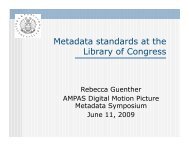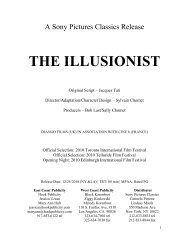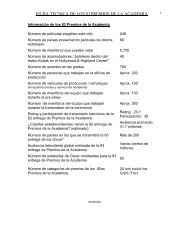Download Report - Academy of Motion Picture Arts and Sciences
Download Report - Academy of Motion Picture Arts and Sciences
Download Report - Academy of Motion Picture Arts and Sciences
You also want an ePaper? Increase the reach of your titles
YUMPU automatically turns print PDFs into web optimized ePapers that Google loves.
is best defined by stating the relatixe intensity at<br />
each wave-length present. This can be determined<br />
by dispersing the radiation into its component parts<br />
<strong>and</strong> then measuring the intensity at each wavelength<br />
by means <strong>of</strong> a suitable instrument, such as a<br />
thermopile, radiometer, or photo-electric cell. Wavelength,<br />
it will be remembered, is usually specified<br />
ln terms <strong>of</strong> a unit called the millimicron (mp.),<br />
which is equivalent to a millionth <strong>of</strong> a millimeter<br />
(0.00000tmm).<br />
The spectral composition <strong>of</strong> the radiation emitted<br />
by difierent light sources used in motion picture<br />
work varies enormously. These sources may, for<br />
convenience, be divided into two classes: (a) those<br />
having a continuous spectrum, <strong>and</strong> (b) those having<br />
a discontinuous or line spectrum. In sources <strong>of</strong> the<br />
first classification it is found that all possible wavelengths<br />
are present <strong>and</strong> <strong>of</strong> this class inc<strong>and</strong>escent<br />
tungsten is typical. In sources <strong>of</strong> the latter class<br />
radiation is emitted at certain definite wave-lengths<br />
only, all other wave-lengths being entirely absent.<br />
Of this class the Cooper-Hewitt mercury vapor<br />
lamp is a well-known example. Sunlight may also<br />
be classed as <strong>of</strong> the continuous spectrum type, although<br />
as a matter <strong>of</strong> fact the spectrum <strong>of</strong> sunlight<br />
shows numerous very narrow dark lines, due to<br />
absorption in the sun's atmosphere. These lines are<br />
so narrow, however, that for all practical purposes<br />
sunlight may be considered as <strong>of</strong> the continuous<br />
spectrum type. The radiation from the crater <strong>of</strong> a<br />
carbon arc is also <strong>of</strong> the continuous type, but due to<br />
certain selectivity absorption characteristics <strong>of</strong> the<br />
arc stream (the flame), the spectrum may contain<br />
certain bright b<strong>and</strong>s or wave-length regions showing<br />
an enhancement <strong>of</strong> intensity. In the case <strong>of</strong> the<br />
flame arcs, the major portion <strong>of</strong> the light is emitted<br />
by the arc stream rather than by the crater <strong>and</strong> the<br />
spectrum is found to be filled with a multitude <strong>of</strong><br />
lines <strong>and</strong> b<strong>and</strong>s which are due to the materials other<br />
than the carbon incorporated in the core. In most<br />
cases these lines <strong>and</strong> b<strong>and</strong>s lie so close together that<br />
for practical purposes the spectrum <strong>of</strong> these arcs<br />
may be considered to approach continuity, although<br />
spectroscopic examination shows a certain preponderance<br />
<strong>of</strong> radiation <strong>of</strong> some wave-lengths <strong>and</strong> absence<br />
<strong>of</strong> others.<br />
The spectral composition <strong>of</strong> the radiation emitted<br />
by any particular source is clearly shown by means<br />
<strong>of</strong> the spectrophotometric curve which is obtained<br />
by plotting for each wave-length the intensity <strong>of</strong><br />
radiation at that wave-length. Since the final analysis<br />
<strong>of</strong> why various colors are rendered as they<br />
are under any specified illumination depends essentially<br />
upon this quality factor, it will be pr<strong>of</strong>itable<br />
to consider in some detail this characteristic <strong>of</strong> various<br />
illuminants.<br />
In Fig. .1 the spectrophotometricurve A shows<br />
the relation between intensity <strong>and</strong> wave-length for<br />
noon sunlight. It will be noted that there is a maximum<br />
at wave-length <strong>of</strong> approximately 500 mp., this<br />
corresponding to the green region in the spectrum.<br />
From the maximum there is a slight decrease for<br />
longer wave-lengths <strong>and</strong> a rather rapid decrease for<br />
the shorter wave-lengths. At wave-length 400,<br />
which represents the limit <strong>of</strong> the visible spectrum<br />
at the short wave-length end, the intensity is only<br />
about one-half <strong>of</strong> that at the maximum. In the<br />
ultra-violet region between 400 m/, <strong>and</strong> 300 mp<br />
the decrease is quite rapid so that at wave-length<br />
300 there is but very little energy. Although the<br />
total energy in this ultra-violet region is relatively<br />
small as compared with that in the visible, it is <strong>of</strong><br />
considerable importance in photographic work because<br />
photographic materials have relatively high<br />
sensitivity to these shorter wave-lengths. Curve B<br />
in Fig. -Z shows the distribution <strong>of</strong> energy in the<br />
p<br />
z<br />
300 400 500 600 rco,<br />
W_LEiGTH tN mf.<br />
FIGURE<br />
Spectral distribution <strong>of</strong> energy in radiation from (A)<br />
noonday sun, (B) north sky.<br />
spectrum <strong>of</strong> north skylight. It will be noted that<br />
the maximum is at approximately 400 m1, <strong>and</strong> that<br />
the decrease in the region <strong>of</strong> long wave-lengths is<br />
rather rapid. It is evident from a comparison <strong>of</strong><br />
this curve with that for sunlight (curve A) that<br />
skylight will appear blue, due to the preponderance<br />
<strong>of</strong> shorter visible wave-lengths as compared with<br />
sunlight. The falling <strong>of</strong>i from the point <strong>of</strong> maximum<br />
intensity in the region <strong>of</strong> shorter wave-lengths<br />
is also quite rapid, so that at 300 mp the value is<br />
quite low.<br />
In Fig, 2 are shown spectrophotometric curves<br />
for the radiation emitted by inc<strong>and</strong>escentungsten.<br />
0<br />
z<br />
:<br />
J<br />
WAVE_ LEren. rN dl.<br />
FIGURE<br />
Spectral distribution <strong>of</strong> energy in radiation from tungsten<br />
filament at various tenDeratures.<br />
I<br />
II<br />
t 30l
















